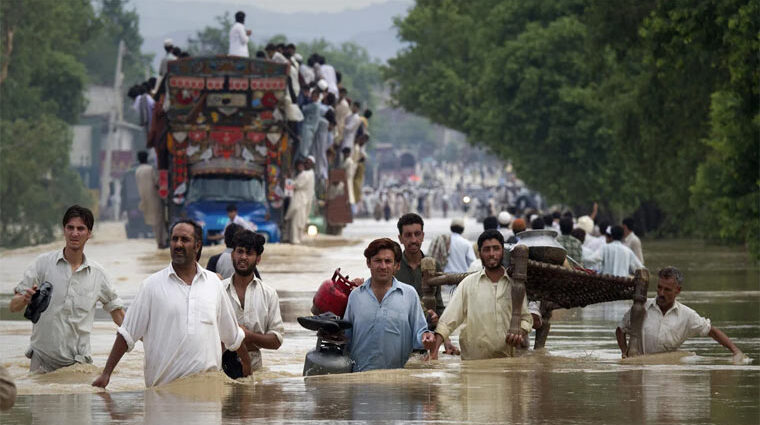Severe Flood Threat in Multan: Authorities Prepare for Critical Situation
Officials fear that a breach at Shershah could affect over 8,000 houses and more than 30,000 residents.
India’s release of additional water into the Sutlej has intensified the crisis. At Head Ganda Singh Wala, the flow surged to 327,000 cusecs
Lahore, Multan, Sukkur, Guddu (Web News)
Authorities in Multan have warned of an “extremely high-level” flood over the next two days, declaring them critical for the city’s safety. To protect urban populations, officials have decided to breach the Shershah flood embankment.
According to technical committees from Multan and Muzaffargarh, the critical water level has been set at 393.50 feet, while the current level at the Shershah flood bund stands at 392.00 feet. The decision was reached after three hours of consultations.
Officials fear that a breach at Shershah could affect over 8,000 houses and more than 30,000 residents. Floodwaters are expected to spread through Sultan Pur Hamr, Jamhur, Kachur, Gagra Mirza Pur, and Bach, reaching as far as Shujabad.

Meanwhile, the Chenab River has already caused devastation in Jalalpur Pirwala tehsil of Multan, where over 100 settlements have been submerged. Rescue operations are underway with the help of helicopters and boats, but thousands of residents have been forced to evacuate. Floodwaters have reached the city’s protective bund, and a red alert has been issued.
Pakistan Railways has requested time from technical teams to clear affected tracks. Road traffic between Multan and Muzaffargarh has been suspended, with diversions set up through Bahawalpur Bypass and Pull Chenab. Head Muhammad Wala Road and the Chenab bridge remain closed, while officials have advised motorists to use the Multan–Sukkur Motorway.
Heavy rains have further worsened the situation. In Multan, a relief camp for flood victims was inundated. In Jalalpur Pirwala, dozens of villages remain underwater. In Layyah’s Noorwala, a rescue boat capsized, claiming three lives, including two women. In Bet Bakhshu, another rescue boat overturned, drowning a child, though 13 others were saved.
India’s release of additional water into the Sutlej has intensified the crisis. At Head Ganda Singh Wala, the flow surged to 327,000 cusecs, submerging dozens of villages. Authorities have demolished the Vehari bridge bund in a desperate bid to save Multan city, declaring the next 12 hours “extremely critical.” Loudspeaker announcements from mosques are urging residents to evacuate immediately.
The Sutlej has also wreaked havoc in Bahawalpur, where nearly 100 villages have been submerged. Standing crops across hundreds of acres have been destroyed. At Minchinabad, 67 villages remain
Sutlej inundation
In Kasur and Bahawalpur, the Sutlej River maintained dangerously high levels, sweeping through farmlands and villages. Floodwaters entered residential localities in Chak Kehil, forcing families to abandon homes as rescue workers moved them to safer ground. The Punjab Irrigation Department reported a water flow of 125,000 cusecs at Head Islam, while Jamlera in Burewala tehsil recorded more than 170,000 cusecs. At Mailsi Siphon, discharge crossed 117,000 cusecs.
Vehari and surrounding tehsils remain under water, with nearly 93 villages inundated and over 61,000 acres of cotton, rice, and sugarcane fields destroyed. More than 80,000 people and 58,000 cattle have been shifted to safety, as local officials warned that further rainfall could worsen conditions.
Chenab overflow
The Chenab River also wreaked havoc in southern Punjab. Jalalpur Pirwala tehsil of Multan saw over 100 settlements submerged, while in Liaquatpur more than 35 villages were engulfed by floodwaters. To protect major towns, embankments such as the Vehari bridge were deliberately breached, though authorities warned the next 12 hours remained critical.
Flood levels in Panjnad and Trimmum areas have been described as dangerous, with heavy rains in Jalalpur Pirwala worsening the plight of flood-hit residents.
Indus under strain
Floodwaters are now moving downstream into Sindh. At Guddu Barrage, flow levels have risen to 416,000 cusecs, with forecasts warning of a surge up to 800,000 cusecs. Authorities fear a vast stretch of kachha areas may be submerged and have placed the region on high alert. In Khanpur, the Indus River has reached 782,000 cusecs, with predictions of close to one million cusecs within 24 hours.
The Sindh government stated the situation remains under control, with continuous monitoring underway, though evacuations are taking place in vulnerable zones. Low-level flooding was also reported at Sukkur.
Rain alert and flood deaths
While Punjab bears the brunt of the current deluge, the flooding has impacted other regions across Pakistan. The Pakistan Meteorological Department has forecast torrential to very heavy rains across Sindh and parts of Balochistan, raising concerns of fresh emergencies.

